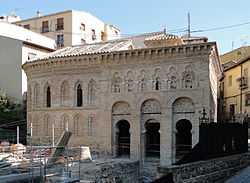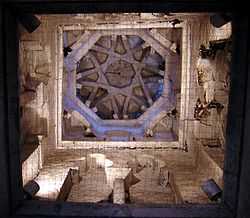Mosque of Cristo de la Luz


The Mosque of Cristo de la Luz is a former mosque in Toledo, Spain, the only one of the ten once existing in the city which remains largely as it was in the Moorish period. It was then known as Mezquita Bab-al-Mardum, deriving its name from the city gate Bab al-Mardum. It is located near the Puerta del Sol, in an area of the city once called Medina where wealthy Muslims used to live.
Architecture
Built in 999 in Toledo, this building is a rarity in that it is in much the same state as it was when it was originally built.[1] The building is a small square structure. It measures roughly 8m X 8m. Four columns capped with Visigothic capitals divide the interior into nine compartments. Covering each of these bays is a vault that has a distinctive design that is unique unto itself. The central vault is higher than the other ones and acts as a cupola for the structure. Each vault employs the use of ribs to create the designs that make them unique. Each of them follows the basic ideas of Islamic design. The ribs typically do not cross in the center, an idea that is seen in many Muslim designs. Some of the designs are more rectilinear while others embrace the curved forms of the vault more prominently. Within each one is a piece of their culture and tradition of building.[1] The columns and the capitals both had been taken from previous buildings and are therefore known as spolia. The building is constructed of brick and small stones. These techniques are a reflection of both the local building tradition as well as the influence from the caliphate in Cordoba. The influence of the caliphate can be seen in the brickwork on the facade of the building which resembles those seen at the Cathedral–Mosque of Córdoba. Originally the Eastern wall was a continuous stretch of brick and served as the qibla wall for the mosque. Also, located along this side would have been a mihrab used for worship. The other three facades are articulated by three bay arcades. All are similar, but individual in their decoration.[2] The Western wall which served as the main entrance is unique in how the arcade is articulated. This facade has a lobed arch, horseshoe arch, and a wider version of a horseshoe arch. Brickwork arches provide the decoration for the facade which are influenced by the architecture in Cordoba. In later years a Mudejar semi-circular apse was added.In the process of the addition the qibla wall and mihrab were lost. By using the mudejar style, there is a smooth transition from the original structure and the apse. This is achieved because the addition uses the same style of decoration and materials as the original. The continuation of the arch motif is an important link between the two sections of the building.[3]
History
An inscription written with brick in Kufic script on the south-west facade reveals the details of the mosque's foundation:
Bismala (in the name of Allah). Ahmad ibn Hadidi had this mosque erected using his own money requesting a reward in paradise for it from Allah. It was completed with the aid of Allah under the direction of Musa ibn Alí, architect and Sa'ada, and concluded in Muharraq in 390 (Islamic calendar).[4]
A shaft of light guided the king to a figurine of the crucified Christ which had been hidden for centuries. He left his shield there with the inscription, "This is the shield which the King Alfonso VI left in this chapel when he conquered Toledo, and the first mass was held here".[1]
In 1186, Alfonso VIII gave the building to the Knights of the Order of St John, who established it as the Chapel of the Holy Cross (Ermita de la Santa Cruz). It was at this time that the mosque was renamed and the apse was added.
See also
- Mezquita de las Tornerias
- Church of San Sebastián, Toledo
Notes and references
- ↑ 1.0 1.1 1.2 Pareja, Antonio. Mezquita de Bab al Mardum, Cristo de la Luz, Toledo 999-1999. [Spain]:Fundacíon Cultura y Deporte Castilla-La Mancha, Junta de Comunidades de Castilla-La Mancha, 1999.
- ↑ Lapunzina, Alejandron. Architecture of Spain. Westport, Conn: Greenwood Press, 2005.
- ↑ Dodds, Jerrilynn Denise, Maria Rosa Menocal, and Abigail Krasner Balbale. The arts of intimacy: Christians, Jews, and Muslims in the making of Castilian culture. New Haven: Yale University Press, 2008.
- ↑ 13 December 999 – 11 January 1000 AD
- King, G., “The Mosque Bab Mardum in Toledo and the Influences Acting Upon It” in: Art and Archaeology Research Papers, 2, 1972, pp. 29–40.
External links
| Wikimedia Commons has media related to Cristo de la Luz (Toledo). |
- Museum With No Frontiers (retrieved on December 4, 2008)
- Page at ArteHistoria (Spanish) (retrieved December 3, 2008)
- Photos of Bab-Mardun on Oronoz.com (retrieved on December 3, 2008)
- Bab Mardum Mosque - An inspiration for Gothic?
Coordinates: 39°51′38″N 4°1′27.3″W / 39.86056°N 4.024250°W